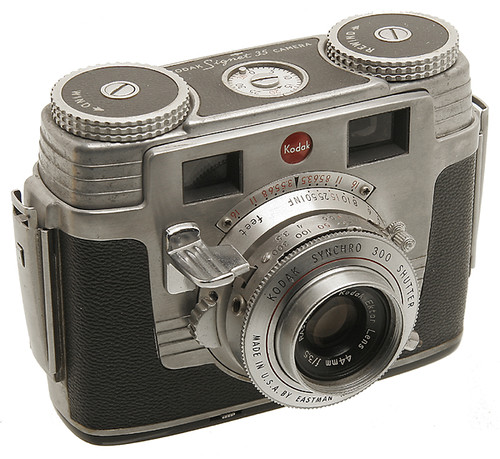Difference between revisions of "Kodak Signet 35"
m (link -> arthur Crapsey (apologies for my Spanish)) |
m (formatting typo) |
||
| Line 8: | Line 8: | ||
The '''Kodak Signet 35''' was [[Kodak]]'s top American-made [[35mm]] camera of the 1950's. The Signet 35 has a coupled coincident image [[rangefinder (device)|rangefinder]], an excellent Ektar 44 mm lens with rear helicoid focus, automatic film stop counter with double exposure prevention, all built into a sturdy cast aluminum alloy body. You have to manually cock the shutter. The shutter works fairly well, but compared with the shutters on equivalent German and Japanese cameras of the period, it's a real disappointment. The design was by [[Arthur H Crapsey]]. | The '''Kodak Signet 35''' was [[Kodak]]'s top American-made [[35mm]] camera of the 1950's. The Signet 35 has a coupled coincident image [[rangefinder (device)|rangefinder]], an excellent Ektar 44 mm lens with rear helicoid focus, automatic film stop counter with double exposure prevention, all built into a sturdy cast aluminum alloy body. You have to manually cock the shutter. The shutter works fairly well, but compared with the shutters on equivalent German and Japanese cameras of the period, it's a real disappointment. The design was by [[Arthur H Crapsey]]. | ||
| − | La '''Kodak Signet 35'' era una cámara fotográfica de [[35mm]], americana de gama superior de [[Kodak]] de los años 50. Es telémetrica, con objetivo excelente Ektar de 44 mm, con el foco helicoide posterior, contador automático de película, con un sistema de doble prevencion de la exposición, construida todo en un cuerpo robusto de aleación de aluminio moldeado. Se tiene que cargar manualmente el obturador. El obturador funciona bastante bien, pero comparado con los obturadores en las cámaras fotográficas alemanas y japonesas equivalentes del período, es verdaderamente inferior. Diseñado por [[Arthur H Crapsey]]. | + | La '''Kodak Signet 35''' era una cámara fotográfica de [[35mm]], americana de gama superior de [[Kodak]] de los años 50. Es telémetrica, con objetivo excelente Ektar de 44 mm, con el foco helicoide posterior, contador automático de película, con un sistema de doble prevencion de la exposición, construida todo en un cuerpo robusto de aleación de aluminio moldeado. Se tiene que cargar manualmente el obturador. El obturador funciona bastante bien, pero comparado con los obturadores en las cámaras fotográficas alemanas y japonesas equivalentes del período, es verdaderamente inferior. Diseñado por [[Arthur H Crapsey]]. |
{{Flickr_image | {{Flickr_image | ||
| Line 14: | Line 14: | ||
|image= http://farm2.static.flickr.com/1085/865426172_62729da1f9.jpg | |image= http://farm2.static.flickr.com/1085/865426172_62729da1f9.jpg | ||
|image_align= left | |image_align= left | ||
| − | |image_text= Kodak Signet 35 (1952)<br> by [http://www.flickr.com/photos/jeronimogirona/ Flickr user jgs4309976] | + | |image_text= Kodak Signet 35 (1952)<br>by [http://www.flickr.com/photos/jeronimogirona/ Flickr user jgs4309976] |
}} | }} | ||
Revision as of 16:46, 9 April 2008

|
| Kodak Signet 35 (1952) by Rick Soloway |
The Kodak Signet 35 was Kodak's top American-made 35mm camera of the 1950's. The Signet 35 has a coupled coincident image rangefinder, an excellent Ektar 44 mm lens with rear helicoid focus, automatic film stop counter with double exposure prevention, all built into a sturdy cast aluminum alloy body. You have to manually cock the shutter. The shutter works fairly well, but compared with the shutters on equivalent German and Japanese cameras of the period, it's a real disappointment. The design was by Arthur H Crapsey.
La Kodak Signet 35 era una cámara fotográfica de 35mm, americana de gama superior de Kodak de los años 50. Es telémetrica, con objetivo excelente Ektar de 44 mm, con el foco helicoide posterior, contador automático de película, con un sistema de doble prevencion de la exposición, construida todo en un cuerpo robusto de aleación de aluminio moldeado. Se tiene que cargar manualmente el obturador. El obturador funciona bastante bien, pero comparado con los obturadores en las cámaras fotográficas alemanas y japonesas equivalentes del período, es verdaderamente inferior. Diseñado por Arthur H Crapsey.

|
| Kodak Signet 35 (1952) by Flickr user jgs4309976 |
Links
- PDF Manual on Mike Butkus's site
- Repair Notes
- Signal 35 at Camera collection by Sylvain Halgand